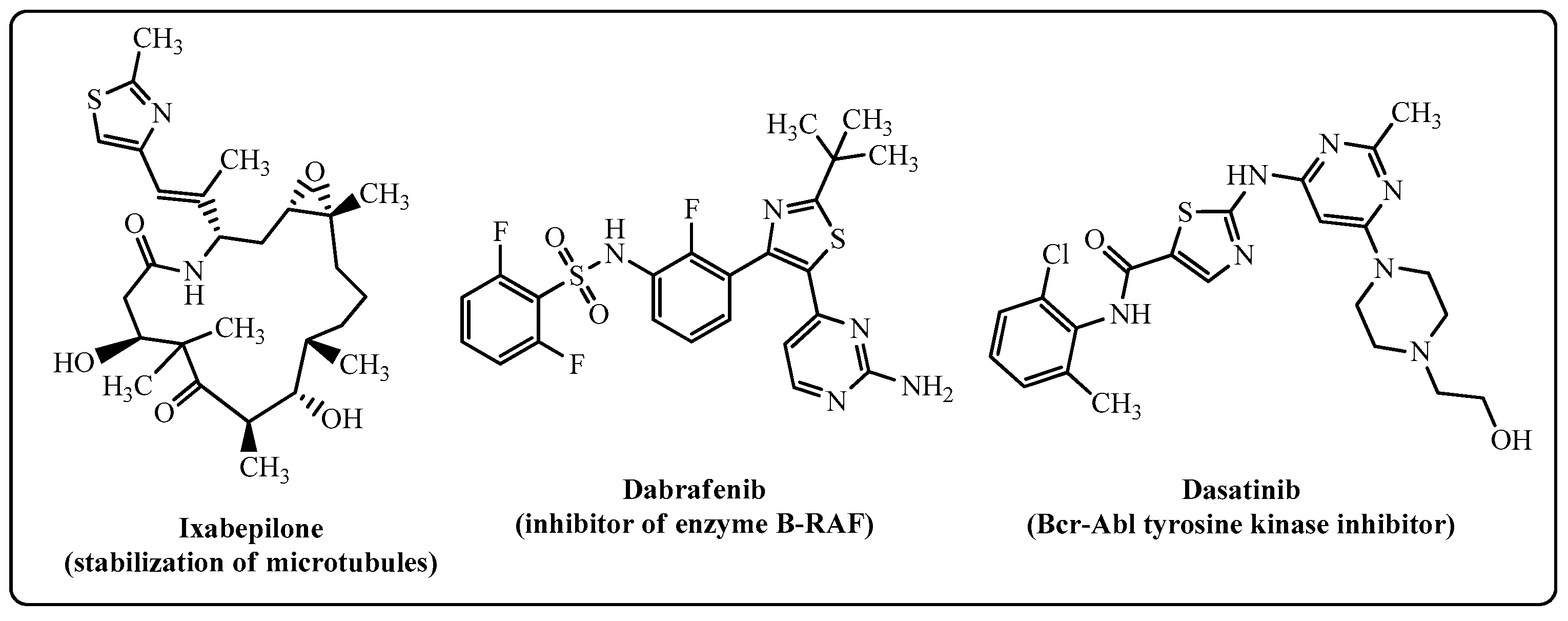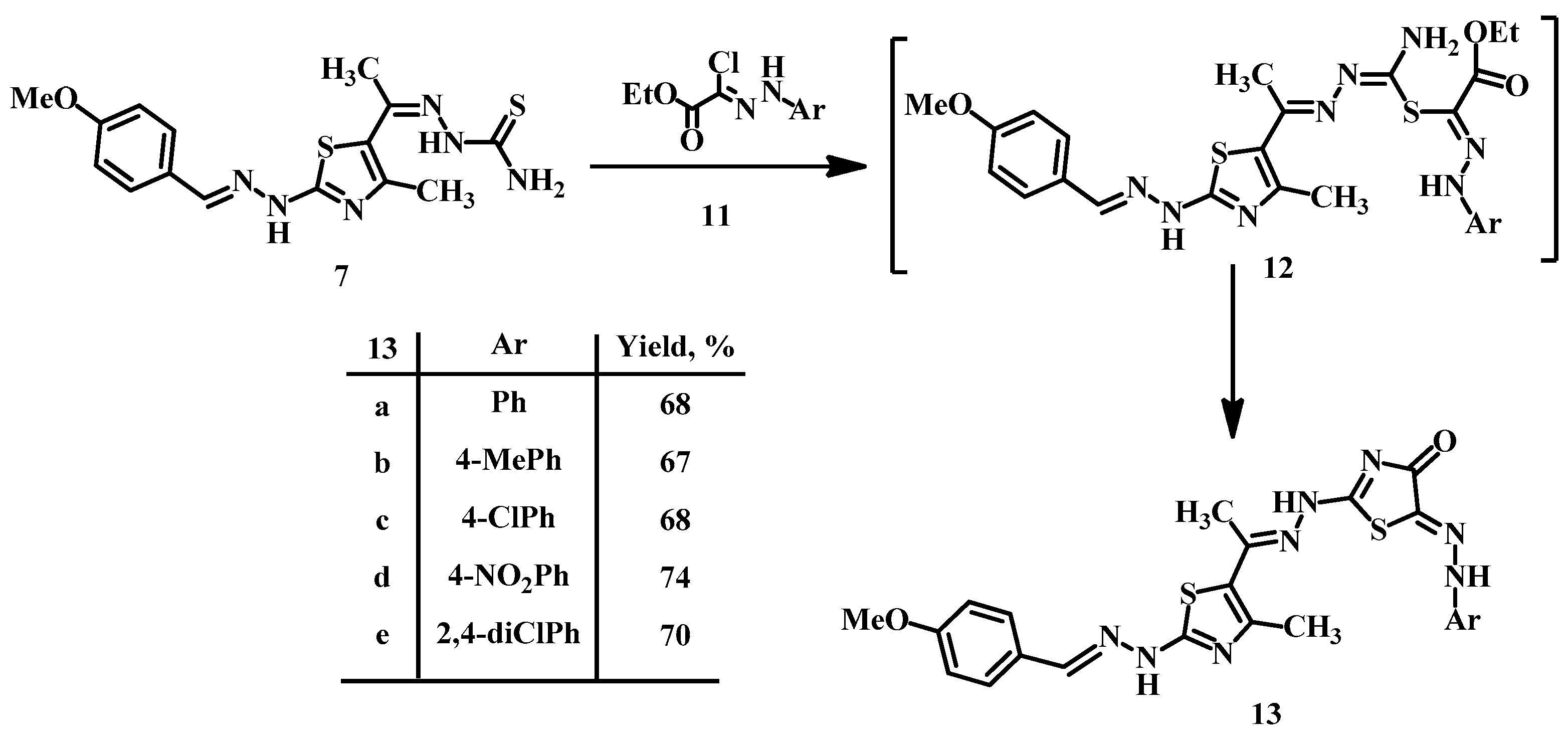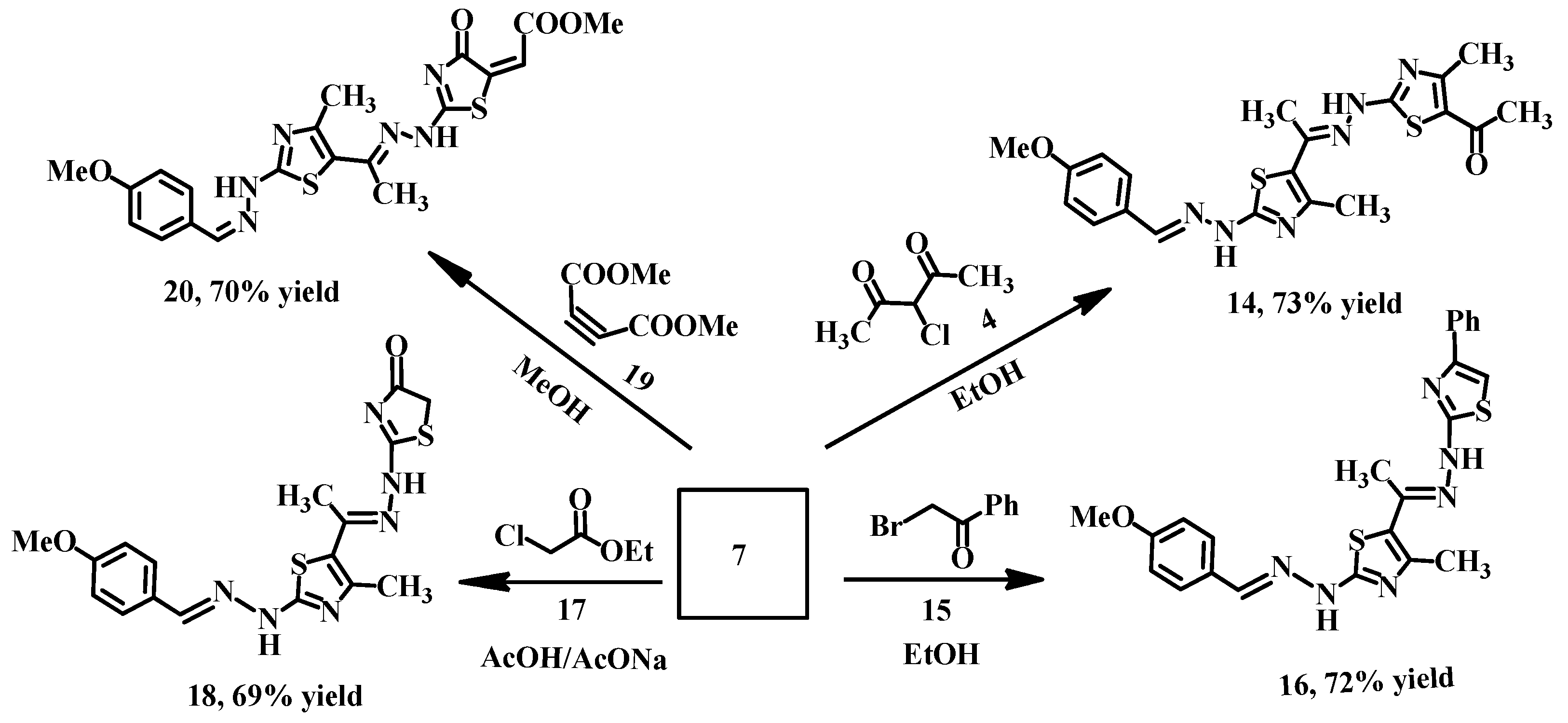Synthesis and Biological Evaluation of Thiazolyl-Ethylidene Hydrazino-Thiazole Derivatives: A Novel Heterocyclic System
Abstract
:1. Introduction
2. Results and Discussion
2.1. Chemistry
2.2. Biological Activities of the Selected Compounds
2.2.1. Antimicrobial Evaluation
2.2.2. Cytotoxic Activity
3. Experimental Section
3.1. Synthesis
3.2. Biological Evaluation
3.2.1. Antimicrobial Activity Assay
3.2.2. MIC Determination
3.2.3. Cytotoxicity Assay
3.2.4. Safety and Selectivity Index (SI)
4. Conclusions
Supplementary Materials
Author Contributions
Funding
Institutional Review Board Statement
Informed Consent Statement
Data Availability Statement
Acknowledgments
Conflicts of Interest
References
- Sharma, P.C.; Bansal, K.K.; Sharma, A.; Sharma, D.; Deep, A. Thiazole—Containing compounds as therapeutic targets for cancer therapy. Eur. J. Med. Chem. 2020, 188, 112016. [Google Scholar] [CrossRef]
- Gomha, S.M.; Badrey, M.G. A convenient synthesis of some new thiazole and pyrimidine derivatives incorporating naphthalene moiety. J. Chem. Res. 2013, 37, 86–90. [Google Scholar] [CrossRef]
- Ouf, S.A.; Gomha, S.M.; Ewies, M.M.; Ouf, A.S.; Sharawy, I.A.; Alharbi, S.A. Antidermatophytic activity of some newly synthesized arylhydrazonothiazoles conjugated with monoclonal antibody. Sci. Rep. 2020, 10, 20863. [Google Scholar] [CrossRef] [PubMed]
- Edrees, M.M.; Abu-Melha, S.; Saad, A.M.; Kheder, N.A.; Gomha, S.M.; Muhammad, Z.A. Eco-friendly synthesis, characterization and biological evaluation of some new pyrazolines containing thiazole moiety as potential anticancer and antimicrobial agents. Molecules 2018, 23, 2970. [Google Scholar] [CrossRef] [Green Version]
- Abdelhamid, A.O.; Shawali, A.S.; Gomha, S.M. Synthesis and anti-microbial evaluation of some novel thiazole, 1,3,4-thiadiazole and pyrido[2,3-d][1,2,4]-triazolo[4,3-a]pyrimidine derivatives incorporating pyrazole moiety. Heterocycles 2015, 91, 2126–2142. [Google Scholar] [CrossRef]
- Gomha, S.M.; Abdelhady, H.A.; Hassain, D.Z.H.; Abdelmonsef, A.H.; El-Naggar, M.; Elaasser, M.M.; Mahmoud, H.K. Thiazole based thiosemicarbazones: Synthesis, cytotoxicity evaluation and molecular docking study. Drug Des. Dev. Ther. 2021, 15, 659–677. [Google Scholar] [CrossRef] [PubMed]
- Gomha, S.M.; Riyadh, S.M.; Abbas, I.M.; Bauomi, M.A. Synthetic utility of ethylidenethiosemicarbazide Synthetic utility of ethylidenethiosemicarbazide: Synthesis and anti-cancer activity of 1,3-thiazines and thiazoles with imidazole moiety. Heterocycles 2013, 87, 341–356. [Google Scholar]
- Gomha, S.M.; Salah, T.A.; Abdelhamid, A.O. Synthesis, characterization and pharmacological evaluation of some novel thiadiazoles and thiazoles incorporating pyrazole moiety as potent anticancer agents. Mon. Chem.-Chem. Mon. 2015, 146, 149–158. [Google Scholar] [CrossRef]
- Sayed, A.R.; Gomha, S.M.; Taher, E.A.; Muhammad, Z.A.; El-Seedi, H.R.; Gaber, H.M.; Ahmed, M.M. One-Pot Synthesis of Novel Thiazoles as Potential Anti- Cancer Agents. Drug Des. Dev. Ther. 2020, 14, 1363–1375. [Google Scholar] [CrossRef] [PubMed] [Green Version]
- Dawood, K.M.; Gomha, S.M. Synthesis and anti-cancer activity of 1,3,4-thiadiazole and 1,3-thiazole derivatives having 1,3,4-oxadiazole moiety. J. Heterocycl. Chem. 2015, 52, 1400–1405. [Google Scholar] [CrossRef]
- Gomha, S.M.; Abdelhamid, A.O.; Kandil, O.M.; Kandeel, S.M.; Abdelrehem, N.A. Synthesis and molecular docking of some novel thiazoles and thiadiazoles incorporating pyranochromene moiety as potent anticancer agents. Mini-Rev. Med. Chem. 2018, 18, 1670–1682. [Google Scholar] [CrossRef]
- Siddiqui, H.L.; Zia-ur-Rehman, M.; Ahmad, N.; Weaver, G.W.; Lucas, P.D. Synthesis and Antibacterial Activity of Bis [2-amino-4-phenyl-5-thiazolyl] Disulfides. Chem. Pharm. Bull. 2007, 55, 1014–1017. [Google Scholar] [CrossRef] [Green Version]
- Gomha, S.M.; Salah, T.A.; Hassaneen, H.M.E.; Abdel-Aziz, H.; Khedr, M.A. Synthesis, characterization and molecular docking of novel bioactive thiazolyl-thiazole derivatives as promising cytotoxic antitumor drug. Molecules 2016, 21, 3. [Google Scholar] [CrossRef] [Green Version]
- Farghaly, T.A.; El-Metwaly, N.; Al-Soliemy, A.M.; Katouah, H.A.; Muhammad, Z.A.; Sabour, R. Synthesis, Molecular Docking and Antitumor Activity of New Dithiazoles. Polycycl. Aromat. Compd. 2021, 48, 1591–1607. [Google Scholar] [CrossRef]
- Rouf, A.; Tanyeli, C. Bioactive thiazole and benzothiazole derivatives. Eur. J. Med. Chem. 2015, 97, 911–927. [Google Scholar] [CrossRef] [PubMed]
- Kashyap, S.J.; Sharma, P.K.; Garg, V.K.; Dudhe, R.; Kumar, N. Review on synthesis and various biological potential of thiazolopyrimidine derivatives. J. Adv. Sci. Res. 2011, 3, 18–24. [Google Scholar]
- Huang, S.; Collony, P.J. Synthesis of 2-N-alkyl (aryl) amino-nitrobenzothiazoles. Tetrahedron Lett. 2004, 45, 9373–9375. [Google Scholar] [CrossRef]
- Geronikaki, A.; Argyropoulou, I.; Vicini, P.; Zani, F. Synthesis and biological evaluation of sulfonamide thiazole and benzothiazole derivatives as antimicrobial agents. Arkivoc 2009, 6, 89–102. [Google Scholar]
- Gomha, S.M.; Riyadh, S.M.; Mahmmoud, E.A.; Elaasser, M.M. Synthesis and anticancer activity of arylazothiazoles and 1,3,4-thiadiazoles using chitosan-grafted-poly(4-vinylpyridine) as a novel copolymer basic catalyst. Chem. Heterocycl. Comp. 2015, 51, 1030–1038. [Google Scholar] [CrossRef]
- Das, D.; Sikdar, P.; Bairagi, M. Recent developments of 2-aminothiazoles in medicinal chemistry. Eur. J. Med. Chem. 2016, 109, 89–98. [Google Scholar] [CrossRef] [PubMed]
- Ansari, M.; Shokrzadeh, M.; Karima, S.; Rajaei, S.; Fallah, M.; Ghassemi-Barghi, N.; Ghasemian, M.; Emami, S. New thiazole-2(3H)-thiones containing 4-(3,4,5-trimethoxyphenyl) moiety as anticancer agents. Eur. J. Med. Chem. 2020, 185, 111784. [Google Scholar] [CrossRef] [PubMed]
- Franchetti, P.; Cappellacci, L.; Grifantini, M.; Barzi, A.; Nocentini, G.; Yang, H.; O’Connor, A.; Jayaram, H.N.; Carrell, C.; Goldstein, B.M. Furanfurin and thiophenfurin: Two novel tiazofurin analogues. Synthesis, structure, antitumour activity, and interactions with inosine monophosphate dehydrogenase. J. Med. Chem. 1995, 38, 3829–3837. [Google Scholar] [CrossRef]
- Altmann, K.H. Epothilone B and its analogs-a new family of anticancer agents. Mini Rev. Med. Chem. 2003, 3, 149–158. [Google Scholar] [CrossRef] [PubMed]
- Yao, Y.; Chen, S.; Zhou, X.; Xie, L.; Chen, A. 5-FU and ixabepilone modify the microRNA expression profiles in MDA-MB-453 triple-negative breast cancer cells. Oncol. Lett. 2014, 7, 541–547. [Google Scholar] [CrossRef]
- Hu-Lieskovan, S.; Mok, S.; Homet Moreno, B.; Tsoi, J.; Robert, L.; Goedert, L.; Pinheiro, E.M.; Koya, R.C.; Graeber, T.G.; Comin-Anduix, B.; et al. Improved antitumour activity of immunotherapy with B-RAF and MEK inhibitors in BRAF(V600E) melanoma. Sci. Transl. Med. 2015, 18, 279. [Google Scholar]
- Li, X.; He, Y.; Ruiz, C.H.; Koenig, M.; Cameron, M.D. Characterization of dasatinib and its structural analogs as CYP3A4 mechanism-based inactivators and the proposed bioactivation pathways. Drug Metab. Dispos. 2009, 37, 1242–1250. [Google Scholar] [CrossRef] [PubMed] [Green Version]
- Netalkar, P.P.; Netalkar, S.P.; Revankar, V.K. Transition metal complexes of thiosemicarbazone: Synthesis, structures and in vitro antimicrobial studies. Polyhedron 2015, 100, 215–222. [Google Scholar] [CrossRef]
- da Silva, E.B.; e Silva, D.A.O.; Oliveira, A.R.; da Silva Mendes, C.H.; Dos Santos, T.A.R.; da Silva, A.C.; de Castro, M.C.A.; Ferreira, R.S.; Moreira, D.R.M.; de Oliveira Cardoso, M.V.; et al. Desing and synthesis of potent anti-Trypanosoma cruzi agents new thiazoles derivatives which induce apoptotic parasite death. Eur. J. Med. Chem. 2017, 130, 39–50. [Google Scholar] [CrossRef] [PubMed]
- Espíndola, J.W.P.; de Oliveira, C.M.V.; de Oliveira, F.G.B.; de Silva, D.A.O.; Moreira, D.R.M.; Bastos, T.M.; de Simone, C.A.; Soares, M.B.P.; Villela, F.S.; Ferreira, R.S.; et al. Synthesis and structure–activity relationship study of a new series of antiparasitic aryloxyl thiosemicarbazones inhibiting Trypanosoma Cruzi Cruzain. Eur. J. Med. Chem. 2015, 101, 818–835. [Google Scholar] [CrossRef]
- Hu, W.X.; Zhou, W.; Xia, C.N.; Wen, X. Synthesis and anticancer activity of thiosemicarbazones. Bioorg. Med. Chem. Lett. 2006, 16, 2213–2218. [Google Scholar] [CrossRef]
- Wang, Y.; Wang, Z.; Kuang, H.; Zhang, Y.; Gu, W.; Zhu, Y.; Wang, S. Synthesis and antitumor activity of 2-isocamphanyl thiosemicarbazone derivatives via ROS-enhanced mitochondria damage. Chem. Biol. Drug Des. 2019, 94, 1281–1291. [Google Scholar] [CrossRef] [PubMed]
- Sayed, A.R.; Abd El-lateef, H.M.; Gomha, S.M. L-Proline catalyzed green synthesis and anticancer evaluation of novel bioactive benzil bis-hydrazones under grinding technique. Green Chem. Lett. Rev. 2021, 14, 179–188. [Google Scholar] [CrossRef]
- Kassab, R.M.; Gomha, S.M.; Muhammad, Z.A.; El-khouly, A.S. Synthesis, biological profile, and molecular docking of some new bis-fused imidazole templates and investigation of their cytotoxic potential as anti-tubercular and/or anticancer prototypes. Med. Chem. 2021, 17, 875–886. [Google Scholar] [CrossRef] [PubMed]
- Gomha, S.M.; Abdelrazek, F.M.; Abdelrahman, A.H.; Metz, P. Synthesis of some novel thiazole, thiadiazole and 1, 4-phenylene-bis-thiazole derivatives as potent antitumor agents. Heterocycles 2016, 92, 954–967. [Google Scholar] [CrossRef] [Green Version]
- Sayed, A.R.; Gomha, S.M.; Abdelrazek, F.M.; Farghaly, M.S.; Hassan, S.A.; Peter, M. Design, efficient synthesis and molecular docking of some novel thiazolyl-pyrazole derivatives as anticancer agents. BMC Chem. 2019, 13, 116. [Google Scholar] [CrossRef] [Green Version]
- Abbas, I.M.; Riyadh, S.M.; Abdallah, M.A.; Gomha, S.M. A novel route to tetracyclic fused tetrazines and thiadiazines. J. Heterocycl. Chem. 2006, 43, 935–942. [Google Scholar] [CrossRef]
- Gomha, S.M.; Kheder, N.A.; Abdelhamid, A.O.; Mabkhot, Y.N. One pot single step synthesis and biological evaluation of some novel bis(1,3,4-thiadiazole) derivatives as potential cytotoxic agents. Molecules 2016, 21, 1532. [Google Scholar] [CrossRef] [Green Version]
- Gomha, S.M.; Eldebss, T.M.A.; Badrey, M.G.; Abdulla, M.M.; Mayhoub, A.S. Novel 4-heteroaryl-antipyrines as DPP-IV Inhibitors. Chem. Biol. Drug Des. 2015, 86, 1292–1303. [Google Scholar] [CrossRef]
- Gomha, S.M.; Abdalla, M.A.; Abdelaziz, M.R.; Serag, N. Eco-friendly one-pot synthesis and antiviral evaluation of pyrazolyl pyrazolines of medicinal interest. Turk. J. Chem. 2016, 40, 484–498. [Google Scholar] [CrossRef] [Green Version]
- Gomha, S.M.; Kheder, N.A.; Abdelaziz, M.R.; Mabkhot, Y.N.; Alhajoj, A.M. A facile synthesis and anticancer activity of some novel thiazoles carrying 1,3,4-thiadiazole moiety. Chem. Cent. J. 2017, 11, 25. [Google Scholar] [CrossRef] [Green Version]
- Gomha, S.M.; Edrees, M.M.; Muhammad, Z.A.; El-Reedy, A.A.M. 5-(Thiophen-2-yl)-1,3,4-thiadiazole derivatives: Synthesis, molecular docking and in-vitro cytotoxicity evaluation as potential anticancer agents. Drug Des. Dev. Ther. 2018, 12, 1511–1523. [Google Scholar] [CrossRef] [Green Version]
- Abu-Melha, S.; Edrees, M.M.; Salem, H.H.; Kheder, N.A.; Gomha, S.M.; Abdelaziz, M.R. Synthesis and biological evaluation of some novel thiazole-based heterocycles as potential anticancer and antimicrobial agents. Molecules 2019, 24, 539. [Google Scholar] [CrossRef] [PubMed] [Green Version]
- Gomha, S.M.; Muhammad, Z.A.; El-Arab, E.E.; Elmetwally, A.M.; El-Sayed, A.A.; Matar, I.K. Design, synthesis, molecular docking study and anti-hepatocellular carcinoma evaluation of new bis-triazolothiadiazines. Mini-Rev. Med. Chem. 2020, 20, 788–800. [Google Scholar] [CrossRef] [PubMed]
- Grozav, A.; Gaina, L.I.; Pileczki, V.; Crisan, O.; Silaghi-Dumitrescu, L.; Therrien, B.; Zaharia, V.; Berindan-Neagoe, I. The Synthesis and Antiproliferative Activities of New Arylidene-Hydrazinyl-Thiazole Derivatives. Int. J. Mol. Sci. 2014, 15, 22059–22072. [Google Scholar] [CrossRef] [PubMed] [Green Version]
- Mehmood, H.; Khalid, M.; Haroona, M.; Akhtar, T.; Ashfaq, M.; Tahir, M.N.; Khan, M.U.; Imran, M.; Braga, A.A.C.; Woodward, S. Synthesis, characterization and DFT calculated properties of electron-rich hydrazinylthiazoles: Experimental and computational synergy. J. Mol. Struct. 2021, 1245, 131043. [Google Scholar] [CrossRef]
- Ibrahim, H.S.; Eldehna, W.M.; Abdel-Aziz, H.A.; Elaasser, M.M.; Abdel-Aziz, M.M. Improvement of antibacterial activity of some sulfa drugs through linkage to certain phthalazin-1(2H)-one scaffolds. Eur. J. Med. Chem. 2014, 85, 480–486. [Google Scholar] [CrossRef]
- Elaasser, M.M.; Abdel-Aziz, M.M.; El-Kassas, R.A. Antioxidant, antimicrobial, antiviral and antitumor activities of pyranone derivative obtained from Aspergillus candidus. J. Microbiol. Biotech. Res. 2011, 1, 5–17. [Google Scholar]
- Mosmann, T. Rapid colorimetric assay for cellular growth and survival: Application to proliferation and cytotoxicity assays. J. Immunol. Methods 1983, 65, 55–63. [Google Scholar] [CrossRef]
- Gomha, S.M.; Riyadh, S.M.; Mahmoud, E.A.; Elaasser, M.M. Synthesis and anticancer activities of thiazoles, 1,3-thiazines, and thiazolidine using chitosan-grafted-poly(vinylpyridine) as basic catalyst. Heterocycles 2015, 91, 1227–1243. [Google Scholar]






| Compound No. | Tested Microorganisms | |||||
|---|---|---|---|---|---|---|
| Fungi | Gram +ve Bacteria | Gram −ve Bacteria | ||||
| A. fumigatus RCMB 002568 | C. albicans ATCC 10231 | B. subtilis NRRL-B-543 | S. aureus RCMB 010010 | E. coli ATCC 25955 | P. vulgaris ATCC 13315 | |
| 6 | 13.4 ± 0.9 | 10.8 ± 0.7 | 9.3 ± 0.9 | 14.3 ± 1.1 | 8.2 ± 0.4 | 17.2 ± 1.2 |
| 7 | 18.5 ± 1.7 | 15.9 ± 1.3 | 15.8 ± 0.6 | 9.1 ± 0.7 | 9.7 ± 0.5 | 18.3 ± 1.1 |
| 10b | 10.9 ± 0.8 | 16.2 ± 0.8 | 13.2 ± 0.8 | 8.5 ± 0.7 | 8.6 ± 0.6 | 10.1 ± 0.7 |
| 10e | 0 | 0 | 8.2 ± 0.6 | 0 | 13.2 ± 0.9 | 8.4 ± 0.8 |
| 13a | 9.1 ± 0.5 | 13.7 ± 0.9 | 10.9 ± 0.9 | 15.2 ± 0.8 | 8.3 ± 0.6 | 9.2 ± 0.8 |
| 13c | 9.3 ± 0.6 | 14.1 ± 0.7 | 16.9 ± 1.3 | 15.8 ± 1.2 | 15.5 ± 1.1 | 12.4 ± 0.8 |
| 13e | 0 | 0 | 8.3 ± 0.4 | 0 | 12.9 ± 0.9 | 7.5 ± 0.6 |
| 16 | 0 | 11.1 ± 0.8 | 9.3 ± 0.5 | 12.6 ± 0.9 | 10.1 ± 0.8 | 13.8 ± 1.4 |
| 20 | 10.2 ± 0.7 | 16.3 ± 1.2 | 12.4 ± 1.1 | 8.1 ± 0.5 | 8.9 ± 0.7 | 7.8 ± 0.5 |
| * Ketoconazole | 23.7 ± 1.1 | 27.6 ± 1.2 | - | - | - | - |
| * Ciprofloxacin | - | - | 29.4 ± 1.4 | 26.1 ± 1.7 | 25.7 ± 1.9 | 28.6 ± 1.8 |
| Compound Code | A. fumigatus RCMB 002568 | C. albicans ATCC 10231 | B. subtilis NRRL-B-543 | S. aureus RCMB 010010 | E. coli ATCC 25955 | P. vulgaris ATCC 13315 |
|---|---|---|---|---|---|---|
| 6 | 2500 | 5000 | 2500 | 1250 | 5000 | 625 |
| 7 | 312.5 | 625 | 625 | 5000 | 5000 | 312.5 |
| 10b | 2500 | 625 | 1250 | 10,000 | 5000 | 5000 |
| 10e | >10,000 | >10,000 | 10,000 | >10,000 | 1250 | 10,000 |
| 13a | 5000 | 1250 | 2500 | 1250 | 5000 | 5000 |
| 13c | 2500 | 625 | 625 | 625 | 625 | 2500 |
| 16 | >10,000 | 5000 | 5000 | 1250 | 5000 | 625 |
| 20 | 5000 | 625 | 2500 | 10,000 | 5000 | 10,000 |
| Ketoconazole | 3.9 | 1.9 | - | - | - | - |
| Ciprofloxacin | - | - | 0.24 | 0.98 | 0.49 | 0.24 |
| Compound No. | IC50 Values * (µM) | ||
|---|---|---|---|
| HepG-2 | HCT-116 | MDA-MB-231 | |
| 6 | 183.2 ± 10.46 | 206.34 ± 9.28 | 219.71 ± 8.57 |
| 7 | 30.67 ± 1.35 | 29.26 ± 1.12 | 64.08 ± 3.84 |
| 10b | 40.73 ± 1.29 | 44.98 ± 1.36 | 58.63 ± 4.71 |
| 10c | 20.95 ± 0.89 | 25.37 ± 0.91 | 44.69 ± 2.35 |
| 10d | 49.57 ± 1.37 | 53.02 ± 1.26 | 85.4 ± 2.19 |
| 10e | 38.84 ± 1.08 | 34.28 ± 0.92 | 57.78 ± 1.36 |
| 13a | 57.26 ± 1.44 | 51.78 ± 1.39 | 97.42 ± 3.95 |
| 13c | 59.01 ± 1.35 | 60.29 ± 1.57 | 105.21 ± 5.13 |
| 13d | 49.15 ± 1.23 | 45.23 ± 1.19 | 85.64 ± 4.12 |
| 13e | 115.79 ± 4.87 | 109.71 ± 3.45 | 214.57 ± 8.31 |
| 16 | 92.21 ± 2.85 | 84.89 ± 3.17 | 160.96 ± 6.42 |
| 20 | 81.68 ± 1.74 | 61.39 ± 2.25 | 133.45 ± 7.91 |
| Cisplatin | 8.63 ± 0.51 | 12.16 ± 0.68 | 11.83 ± 0.79 |
| Compound No. | CC50 Values (µM) | SI Values * (CC50/IC50) | ||
|---|---|---|---|---|
| HepG-2 | HCT-116 | MDA-MB-231 | ||
| 6 | 734.13 ± 59.35 | 4.01 | 3.56 | 3.34 |
| 7 | 175.92 ± 18.24 | 5.74 | 6.01 | 2.75 |
| 10b | 181.89 ± 15.07 | 4.47 | 4.04 | 3.10 |
| 10c | 197.26 ± 13.48 | 9.42 | 7.78 | 4.41 |
| 10d | 109.74 ± 5.92 | 2.21 | 2.07 | 1.29 |
| 10e | 203.71 ± 11.83 | 5.24 | 5.94 | 3.53 |
| 13a | 214.65 ± 14.21 | 3.75 | 4.15 | 2.20 |
| 13c | 251.32 ± 30.94 | 4.26 | 4.17 | 2.39 |
| 13d | 229.14 ± 17.29 | 4.66 | 5.07 | 2.68 |
| 13e | 278.02 ± 28.64 | 2.40 | 2.53 | 1.30 |
| 16 | 211.96 ± 16.28 | 2.30 | 2.50 | 1.32 |
| 20 | 189.43 ± 11.91 | 2.32 | 3.09 | 1.42 |
| Cisplatin | 58.75 ± 3.87 | 6.81 | 4.83 | 4.97 |
Publisher’s Note: MDPI stays neutral with regard to jurisdictional claims in published maps and institutional affiliations. |
© 2021 by the authors. Licensee MDPI, Basel, Switzerland. This article is an open access article distributed under the terms and conditions of the Creative Commons Attribution (CC BY) license (https://creativecommons.org/licenses/by/4.0/).
Share and Cite
Al-Mutabagani, L.A.; Abdelrazek, F.M.; Gomha, S.M.; Hebishy, A.S.; Abdelfattah, M.S.; Hassan, S.M.; Sayed, A.R.; Elaasser, M.M. Synthesis and Biological Evaluation of Thiazolyl-Ethylidene Hydrazino-Thiazole Derivatives: A Novel Heterocyclic System. Appl. Sci. 2021, 11, 8908. https://doi.org/10.3390/app11198908
Al-Mutabagani LA, Abdelrazek FM, Gomha SM, Hebishy AS, Abdelfattah MS, Hassan SM, Sayed AR, Elaasser MM. Synthesis and Biological Evaluation of Thiazolyl-Ethylidene Hydrazino-Thiazole Derivatives: A Novel Heterocyclic System. Applied Sciences. 2021; 11(19):8908. https://doi.org/10.3390/app11198908
Chicago/Turabian StyleAl-Mutabagani, Laila A., Fathy M. Abdelrazek, Sobhi M. Gomha, Ali S. Hebishy, Mohamed S. Abdelfattah, Safaa M. Hassan, Abdelwahed R. Sayed, and Mahmoud M. Elaasser. 2021. "Synthesis and Biological Evaluation of Thiazolyl-Ethylidene Hydrazino-Thiazole Derivatives: A Novel Heterocyclic System" Applied Sciences 11, no. 19: 8908. https://doi.org/10.3390/app11198908
APA StyleAl-Mutabagani, L. A., Abdelrazek, F. M., Gomha, S. M., Hebishy, A. S., Abdelfattah, M. S., Hassan, S. M., Sayed, A. R., & Elaasser, M. M. (2021). Synthesis and Biological Evaluation of Thiazolyl-Ethylidene Hydrazino-Thiazole Derivatives: A Novel Heterocyclic System. Applied Sciences, 11(19), 8908. https://doi.org/10.3390/app11198908









